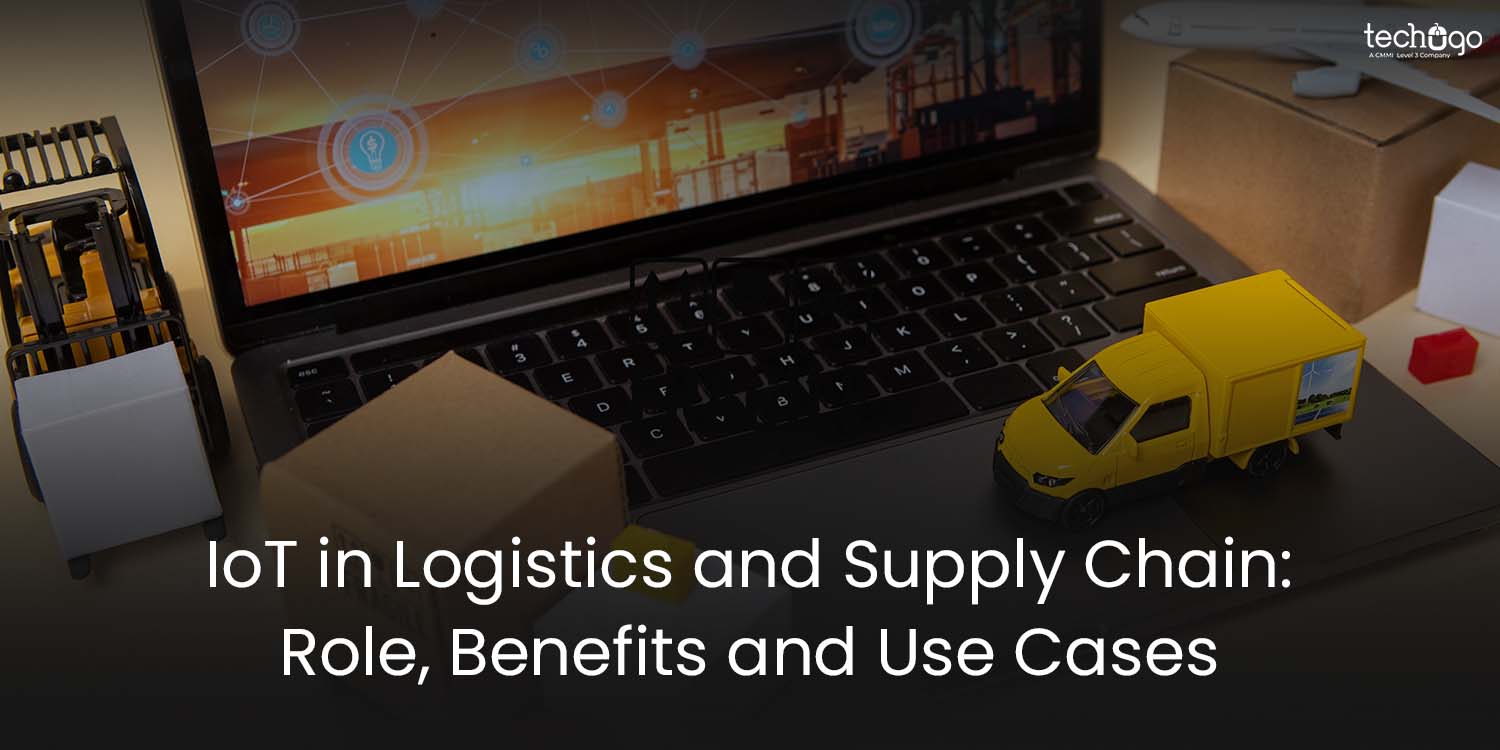3 Mar 2023
IoT in Logistics and Supply Chain: Role, Benefits and Use Cases

The Internet of Things will soon connect 50 billion devices. It will create a global network of interconnected devices, computer networks, and sensors that all use the internet protocol. As the industry adopts the necessary technology, the Internet of Things is evolving for logistics and supply chain management.
Technology’s nature also provides many benefits and opportunities for supply chain monitoring and vehicle tracking, inventory management, and safe transportation.
IoT in Logistics & Supply Chain Operations
Inventory Tracking and Management
Inventory management and tracking are the most critical parts of the connected logistics ecosystem. The inexpensive and small sensors can be used to monitor warehouse errors and to create an intelligent system that prevents any losses.
IoT can improve logistics operations by ensuring safe storage and locating the goods needed. Nearly all logistics companies use IoT in their logistics operations. IoT technology allows for the elimination of human error.
Predictive Analytics for Route Optimization
Predictive analytics helps logistics businesses and companies to develop effective strategies, manage risk and gain valuable business insight.
IoT is a way to gather large amounts of data from devices and send it to the central system to be analyzed. IoT and do all tasks that involve rushing and lifting heavy loads. It has QR codes embedded on its warehouse floor to aid robots in finding their way.
Humans accompany the robots, but the human workers focus on problem-solving and dexterity.
Amazon has been able to store 50% more stock and retrieve inventory three times faster using IoT-enabled automated. The cost to build a mobile app is also reduced by 40%.
Remote Container Management: Remote container management (RCM) technology allows for monitoring the location and temperature of refrigerated containers. It displays the status of the power connection at all times, both onboard and during transport.
- It monitors the weather and other environmental conditions to plan better and implement transportation.
Predictive Maintenance Solution: This helps to optimize equipment maintenance using sensors, AI, and data science. It minimizes maintenance costs and maximizes equipment uptime.
- We use Fluid Monitoring, a predictive maintenance system, to maintain their engine plant in Lyon.
- It monitors five engine test cells at the Group Truck Operations (GTO) factory.
- The system notifies the maintenance team before anything goes wrong. They could therefore avoid having to stop engine tests. They save a lot of time and money.
Also Read : Logistics App Development : What all it Takes?
5 Ways IoT can Boost Supply Chain and Logistics Businesses
It is time for more IoT in logistics and supply chain companies to embark on their IoT adoption journey.
These are five innovative ways IoT technology can improve your supply chain operations and logistics business.
1. Improve Inventory Management
- In the supply chain, inventory management is about ensuring you have enough material to deliver orders and strategically placing orders for timely delivery.
- Traditional supply chains are not designed to handle small orders and large quantities. It is impossible to predict the future needs of your business.
- You can monitor inventory levels, get insight into inventory status, and make informed business decisions to prevent product shortages.
- These systems provide data that can help predict future inventory requirements.
- You can also monitor the physical aspects of your product, such as damage and leakage. IoT makes it simple to update asset information without needing any manual intervention.
- Access to every delivery’s essential information, including parcel contents and storage manuals, is available.
- You can create an intelligent warehouse using IoT to manage inventory assets remotely, prevent over/underloading, monitor supply levels, track the condition and locate goods quickly.
2. Transparency is key
- Businesses must ensure transparency across all supply chain partners.
- IoT accomplishes precisely that: it adds transparency and prevents disruptions.
- You can track your drivers and shippers and verify they follow the IoT policies.
- It is possible to be more aware of how the product has been stored and any delays in delivery between the warehouse and your doorstep.
- You have instant access to all information, so there’s nothing to hide in case of a problem. This allows you to communicate with clients better and keep them updated.
3. Managing last-mile deliveries
- Although the goods may travel thousands of miles to reach their destination, the last mile – from the local distribution center to the final destination – is often the most costly and wasteful.
- According to a 2019 survey, last miles account for 41 percent of supply chain costs.
- IoT is an excellent solution for companies that want to reduce the time it takes to deliver last-mile orders.
- GPS and IoT can identify optimal routes to reduce fuel consumption and traffic delays. IoT’s real-time traffic analytics and IOT’s capabilities for real-time notification of problems make all this possible.
Also Read : Tinyml; A Futuristic Technology Reshaping Iot Apps!
4. Fleet Management
- Are you responsible for delivering a fleet of vans, trucks, forklifts, cranes, and other equipment from your warehouse?
- You can monitor your vehicle fleet with IoT sensors and alert you if there is a problem.
- You will also receive timely updates about the driver’s health, traffic conditions, and other information that may help you to improve your fleet management strategies.
- IoT implementation can lower fuel costs and streamline vehicle maintenance.
5. Predictive maintenance
- Most warehouses and supply chains have a set maintenance schedule. This includes taking equipment off-site to inspect and repair to keep it functional.
- This is the most common maintenance strategy. Is it the best?
- IoT allows you to anticipate when equipment may need repair or replacement instead of relying on preventive maintenance. IoT sensors monitor equipment health and transmit that information to warehouse management software This will notify you when equipment needs to be removed and repaired to avoid costly downtime.
- You can use the IoT to your advantage in various ways, including exploring its new uses.
Supply Chain and Logistics Industry Challenges
Supply chain and logistics, like many other industries, are changing. Both supply chain and logistics are facing new challenges due to technological innovation, strict government regulations, and customer expectations.
These issues can quickly become significant problems if you wait to address them.
Here are some challenges that require quick action from supply chain and logistic companies.
Transportation costs are rising
The logistics industry faces a significant challenge in reducing rising transportation costs. The logistics costs can easily exceed 50% of total expenditure in specific sectors. Increasing fuel prices only exacerbates this problem.
It is clear that rising fuel/diesel costs directly affect transportation costs. Moreover, fuel prices rise, which in turn increases freight rates.
Besides high fuel and freight prices, logistics operations are also under pressure due to rising commodity prices, increased labor costs, and more global customers.
Redundant business processes
Supply chain and logistics companies are under increasing pressure to develop innovative ways to plan, strategize and offer services. They must also improve their business processes, such as delivery density and utilizing production capacity.
Top App development company must be aware of the latest technological developments.
This process improvement will allow you to provide better customer service and increase operational efficiency.
Companies need help to implement these improvements and require assistance.
Customer expectations are changing.
Logistics is about managing changing customer requirements and building lasting customer relationships.
Customers want to know exactly where their deliveries are at all times. Customers also expect seamless delivery right from the moment they place an order.
Your customers may be able to understand the complexities, but they also expect service providers to handle everything efficiently and cost-effectively.
Despite high expectations for service, customer’s willingness to pay more for faster shipping has declined. A Survey found that 64 percent of respondents were unwilling to pay more for shipping within two days.
Logistics companies are under pressure to provide a superior customer experience without compromising on time or money.
Economic Impact
Logistics is directly connected to production and consumption and facilitates commerce and trade. However, high fuel prices and rising inflation lead to a credit crisis that can impact growth.
Additionally, the political situation, the decline in manufacturing sector performance, and the consumer price index have an impact on the demand for products/services. This further impacts the freight demand.
Also Read : What Role does Pharmaceutical Manufacturing Software play in the Pharmaceutical Industry?
Cash flow management
Cash flow management is essential for most businesses, particularly in the supply and logistics chain.
Cash flow is difficult to predict. All parties – shippers, carriers, vendors – are pressured to provide faster cash influx and slower outgoing money due to tightening global supply chains.
Companies need to make long-term cash flow improvements. However, determining where and when resources should be allocated with so many entities simultaneously can be challenging.
Inventory Control and Visibility
Every iOT app development company needs to know the inventory they have and where it is located at all times.
This visibility and control can be crucial to your business but can be difficult.
Poor inventory management can lead to delayed, incorrect, or incomplete shipments.
Technology developments: Implementing
While iOT in logistics and supply chain companies know that tech innovations are necessary to stay competitive, it is costly to adapt to new technology.
IoT and other digital solutions using AI/ML, drones, and robots are great ways to advance traditional supply chains.
These can make your ecommerce process more efficient, cost-effective, and effective. However, implementing these solutions across your company’s existing supply chains is the real challenge.
Putting these techs in action takes time and organizational alignment, especially when working with multiple warehouses or omnichannel sales.
Accountability and compliance
International supply chain companies must be mindful of social compliance.
Unfair work compensation, child labor practices, and unacceptable working conditions are just a few of the many factors that encourage unethical global supply chain practices.
There are many ways to ensure supply chain partners follow ethical standards. However, it is essential to be cautious.
These issues can lead to brand damage or legal action.
These challenges can seem daunting, but with the right technologies and solutions, you can overcome them and make your business more efficient.
Conclusion
The IoT in logistics and supply chain opens up new possibilities for real-time data collection and an efficient supply chain. It will soon play a vital role in detecting problems with the supply chains and log supply chains and logistics app early. The Internet of Things is a new technology in logistics, but modern businesses should be using it to identify potential problems with the supply chain and logistics system. A talented team is essential for both the design and development phases—Contact Techugo, an on demand app development company to get your IoT in logistics and supply-chain solution in line with current tech trends.
Get in touch.
Write Us
sales@techugo.comOr fill this form



 SA
SA  KW
KW  IE
IE AU
AU UAE
UAE UK
UK USA
USA  CA
CA DE
DE  QA
QA ZA
ZA  BH
BH NL
NL  MU
MU FR
FR 













